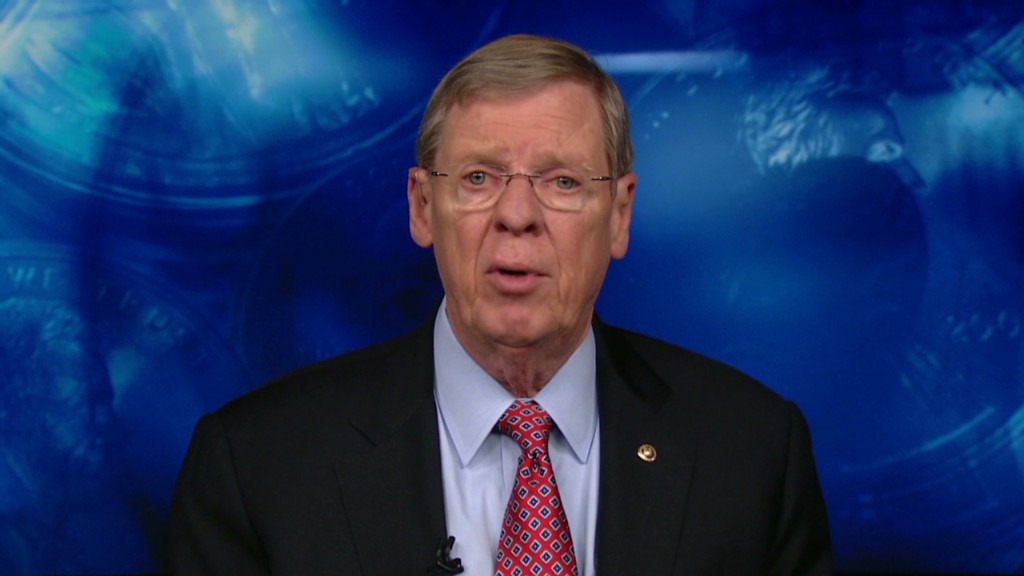
The budgets of most federal government programs and agencies will shrink on March 1.
Congress could prevent that from happening, but it's not likely to do so before the deadline.
It's still unclear, however, whether Congress would let the so-called funding sequester stay in effect for long.
So one way or another, here come the cuts.
What is the sequester exactly? It's just a fancy word for automatic, across-the-board cuts in funding.
How much will be cut? The sequester would slash how much federal agencies are allowed to spend by $85 billion over seven months.
The White House estimates that funding for nondefense programs would be cut by 9%, while defense programs would be cut by 13%, for the seven months remaining in fiscal year 2013, which ends Sept. 30.
The funding reductions would come primarily from what's known as discretionary spending. Discretionary spending supports a vast array of programs, agencies and services from the FBI to the FDA to support for the Corporation for Public Broadcasting.
There would also be some cuts in mandatory spending, which unlike discretionary spending isn't subject to annual review by Congress. But popular entitlements such as Medicare and Social Security would be largely protected. So would safety-net programs such as Medicaid and food stamps.
Also exempt: military personnel and Veterans Affairs, although veterans may be hit in other ways, especially since they're a big part of the Defense Department's civilian workforce.
Related: 57 ways budget cuts could sting
What would be affected? Most federal programs and activities.
Indeed, the cuts on non-exempt areas will be broadly felt. Food inspections, border security, weather monitoring, medical research, disaster response, education programs and Meals on Wheels for seniors would be compromised.
Federal workers at different agencies would face furloughs. They may be told not to come to work one or two days every week or every pay period until September. And they won't be paid for those furloughed days.
"Core operations would have to be shut down or curtailed across nearly all federal agencies," White House Budget Office Controller Danny Werfel said in testimony before the Senate Appropriations Committee.

How quickly will the cuts hit? It depends.
Anticipation of the sequester has already caused federal agencies to slow or freeze hiring and to limit the contracts they issue for future services and products. They've also reduced travel and training costs.
But come March 1, it's not as if all the reductions that are planned will happen overnight.
Practically, federal workers facing furloughs must be given at least 30 days' notice. Even though a number of federal agencies said they will do furloughs, official notices aren't expected to go out until March 1 at the earliest. So actual furloughs may not occur until April.
Second, the White House budget office can tell agencies how to apportion their reduced budgets so that the effects of the funding cut might not need to occur right away. "There's some discretion," said Pete Davis, a former Capitol Hill staffer who now runs a Washington research firm.
That kind of leeway might allow lawmakers some time to figure out how to avert the full effects of the sequester.
So there's a chance the sequester could be replaced? Yes, increasingly policy observers expect Congress will at least try to replace it by March 27, although there are no guarantees.
March 27 is the day funding for the government expires. To prevent a government shutdown on March 28, lawmakers must pass another funding bill -- if not for the rest of the year, then at least for a few weeks or months.
If lawmakers choose to replace the sequester, they would likely do so with a set of savings -- some real, some gimmicky -- elsewhere in the budget. And it's possible the savings would be realized over 10 years, rather than all in 2013.
What's wrong with the sequester? It's a thoughtless, abrupt, poorly targeted way to cut spending. Sure, it will help reduce deficits in the near-term. But it won't do so in areas that are actually drivers of the country's debt.
In fact, the sequester was never intended to go into effect. The mere threat that it might was supposed to prod lawmakers to find a smarter, more gradual way to reduce deficits.
But Democrats and Republicans still can't agree on how, despite knowing this day would come for over a year.
House Republicans have proposed replacing the defense cuts with more nondefense reductions. Senate Democrats want to replace all the cuts with a mix of targeted spending cuts and tax increases. Each side rejects the other's solution.
How much will the sequester reduce deficits? Between now and 2023, projected spending would be reduced by more than $1 trillion if the sequester plus related spending caps in subsequent years are left in place, according to Congressional Budget Office estimates.
Will the sequester hurt the economy? Yes, if it stays in effect for the rest of the calendar year.
The CBO estimates that it could reduce economic growth by at least 0.6 percentage points and reduce job growth by 750,000 jobs.
Coupled with this year's payroll tax cut expiration and the higher tax rates on high-income households, the CBO estimates growth will be curtailed by a total of 1.5 percentage points.


